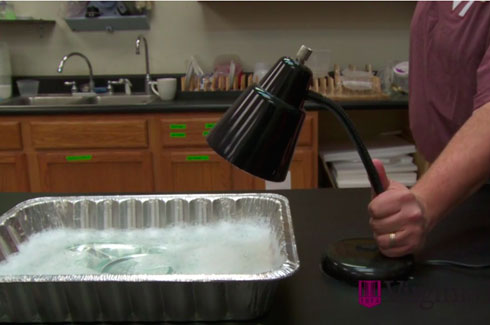Stink bugs beware! Homemade stink bug traps squash store-bought models, Virginia Tech researchers find

Editor's note: Updated version of this story and video here.
A Virginia Tech team of researchers has proven that homemade, inexpensive stink bug traps crafted from simple household items outshine pricier models designed to kill the invasive, annoying bugs.
This discovery comes just as warm weather is coaxing the critters out of crevices of the homes they were hiding in during the cold winter and homeowners will be looking for a way to get rid of the pest.
Researchers from the College of Agriculture and Life Sciences found that the best way to get rid of the little buggers is to fill a foil roasting pan with water and dish soap and put a light over the pan to attract the bugs in a dark room.
The trap eliminated 14 times more stink bugs than store-bought traps that cost up to $50, the study found. The only price of the homemade model is the cost of a roasting pan, dish soap, and a light — all which homeowners may already own.
Though the solution is not new and has been promoted on Youtube and other websites, this is the first time it was actually tested in a scientific experiment. The findings will be published in an upcoming issue of the Journal of Extension.
A video on how to make the trap can be found on the Virginia Tech Vimeo page.
“We knew that insects are generally attracted to light, so we were able to exploit that with these traps,” said John Aigner, a doctoral student in the Department of Entomology.
To conduct the study, Aigner and Tom Kuhar, an entomology professor and Virginia Cooperative Extension specialist, enlisted the help of citizen scientists — homeowners who were annoyed by the infestation of stink bugs in their houses — to evaluate different types of traps for ridding homes of bugs. The study was conducted in 16 houses over two years.
“Currently there are no in-home insecticides labeled for use against brown marmorated stink bugs, so that presented us with a challenge,” Aigner said.
The homemade trap is not only inexpensive, it is also pesticide-free.
Unfortunately, the traps are only practical in homes. Farmers around the mid-Atlantic have seen millions of dollars in damage to their crops since the brown marmorated stink bug invaded the region in the late 2000s. The bug is now found in 41 states. Still, the solution could give some reprieve to homeowners who find thousands of these cilantro-smelling bugs in their homes.
“The real devastation comes in the form of damage to farmers,” said Kuhar. “Stink bugs feed as nymphs and adults on the fruit and pods of plants, which maximizes their chances to render a crop unmarketable. These bugs have been documented to feed on many of our important agricultural crops including apples, peaches, grapes, soybeans, peppers, tomatoes, corn, and cotton.”
Treatment of the insects in crops is costly because the insecticides required to control it are broad spectrum toxicants that are highly disruptive to integrated pest management programs.
“The few native natural enemies they have can easily be killed with the same insecticide used to target the stink bugs themselves,” he said.






